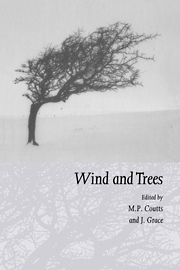Book contents
- Frontmatter
- Contents
- Preface
- List of contributors
- Part I Airflow over topography and in forests
- Part II Mechanics of trees under wind loading
- Part III Tree physiological responses
- Part IV Impacts of wind on forests and ecology
- 18 Hurricane disturbance regimes in temperate and tropical forest ecosystems
- 19 A comparison of methods for quantifying catastrophic wind damage to forests
- 20 Windthrow and airflow in a subalpine forest
- Part V Risk assessment and management response
- Index
19 - A comparison of methods for quantifying catastrophic wind damage to forests
Published online by Cambridge University Press: 27 October 2009
- Frontmatter
- Contents
- Preface
- List of contributors
- Part I Airflow over topography and in forests
- Part II Mechanics of trees under wind loading
- Part III Tree physiological responses
- Part IV Impacts of wind on forests and ecology
- 18 Hurricane disturbance regimes in temperate and tropical forest ecosystems
- 19 A comparison of methods for quantifying catastrophic wind damage to forests
- 20 Windthrow and airflow in a subalpine forest
- Part V Risk assessment and management response
- Index
Summary
Abstract
Catastrophic wind events impact forests over the entire globe. Although recent examples of hurricanes in the Caribbean have led to intense examination of the impacts on, and recovery of, forests, these research efforts have largely been in isolation. Little has been done to compare the impacts of storms of varying intensity on different ecosystems. Therefore, we can not as yet fit catastrophic wind events into a general model of forest disturbance and recovery. Papers examining the impacts of 26 different wind events (cyclonic storms, tornadoes and gales) on 27 different forests are reviewed. Hurricane damage is measured as numbers or percentage: stem damage, canopy damage, biomass or stand volume loss, or mortality. The populations sampled varied from minimum stem size of 2 cm to 20 cm in diameter. Sampling methodology included small circular plots, transects, large gridded plots and remote sensing of the landscape. Plots were established 10 days to 3 years after the wind event. The implications of these different quantification systems are examined using data from a large gridded plot established in the Luquillo Mountains of Puerto Rico to study the impacts of Hurricane Hugo. Intensity of disturbance, measured as percentages of different damage types, varied depending on the minimum stem size used in the analysis. Damage to individual species also varied depending on the variable used to quantify it. Clearly, a standard measure of wind damage is needed to facilitate comparisons of the impacts of different storms on different forests. I suggest a damage measure that includes both mortality and structural loss as measured by decrease in basal area.
- Type
- Chapter
- Information
- Wind and Trees , pp. 340 - 357Publisher: Cambridge University PressPrint publication year: 1995
- 9
- Cited by



